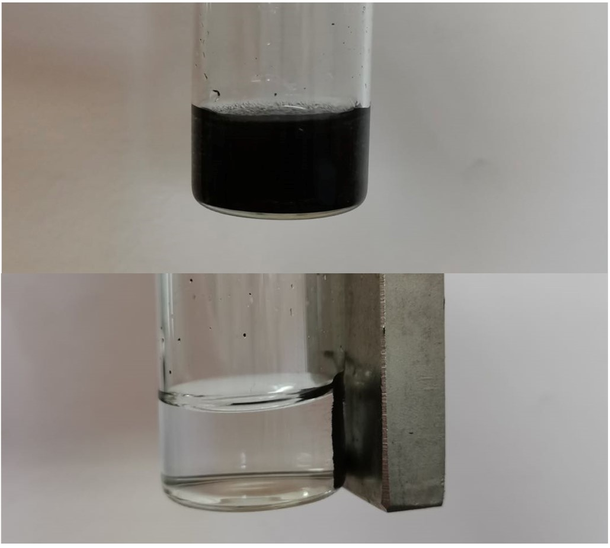Membrane filters do not need a lot of energy for water purifications; thus, it makes them a popular choice for wastewater treatment.
 Nanoparticles (top image) efficiently break down pollutants and are magnetic, making them easily recoverable for reuse (bottom image). Image Credit: Adapted from ACS Applied Materials & Interfaces 2022.
Nanoparticles (top image) efficiently break down pollutants and are magnetic, making them easily recoverable for reuse (bottom image). Image Credit: Adapted from ACS Applied Materials & Interfaces 2022.
These materials are usually cleaned with plenty of strong chemicals to keep them in excellent condition. However, a few of these agents damage the membranes during the process.
Scientists have now designed reusable nanoparticle catalysts that can incorporate glucose to aid in successfully breaking down contaminants within these filters without destroying them. The study was published in ACS Applied Materials & Interfaces.
Generally, clogs of dirty wastewater filters are removed with strong acids, bases or oxidants. The oxidants that contain chlorine, such as bleach, could break down the toughest organic debris. However, they also harm polyamide membranes, present in most commercial nanofiltration systems, and they give rise to toxic byproducts.
Although hydrogen peroxide is a milder substitute to bleach, it decomposes contaminants slowly. Earlier research involved combining hydrogen peroxide with iron oxide to create hydroxyl radicals that enhance the efficiency of hydrogen peroxide in a process called the Fenton reaction.
However, for the Fenton reaction to purify filters, additional hydrogen peroxide and acid are required, which increase monetary and ecological costs. Using the enzyme glucose oxidase is one way to avoid such additional chemicals, thereby consequently forming hydrogen peroxide and gluconic acid from oxygen and glucose.
Thus, Jianquan Luo and colleagues decided to mix glucose oxidase and iron oxide nanoparticles into a system that enhances the Fenton-based breakdown of contaminants, making a delicate and effective cleaning system for membrane filters.
Initially, the scientists compared the elimination of organic contaminants from polyamide filters through the glucose oxidase enzyme and iron oxide nanoparticles to various other cleaning methods, in addition to the conventional Fenton reaction. They discovered that this method was more efficient at breaking down bisphenol A and methylene blue (the common contaminants), simultaneously conserving more of the membrane structure.
Motivated by the initial results, the team integrated glucose oxidase and iron oxide into a single nanoparticle, by joining them with an amino bridge. Ultimately, they assessed the new nanoparticle’s capacity to purify methylene blue-soaked nanofiltration membranes, which they contaminated and cleaned for three cycles.
After every cleaning cycle, the nanoparticles were withdrawn with a magnet and repurposed with fresh glucose in order to trigger the catalyst. The nanoparticles were efficiently cleansing the membranes, which gave a return of 94% of their initial water filtration capacity.
Since the nanoparticles do not need strong chemicals and are seamlessly recoverable, the scientists propose that their new system is a “greener” and more economical method for cleaning nanofiltration membranes.
The study was funded by the Beijing Natural Science Foundation and the National Natural Science Foundation of China.
Journal Reference:
Zhang, J., et al. (2022) Chemoenzymatic Cascade Reaction for Green Cleaning of Polyamide Nanofiltration Membrane. ACS Applied Materials & Interfaces. doi.org/10.1021/acsami.1c23466.